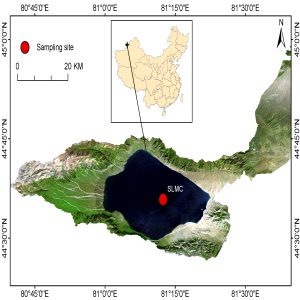The prevalence of Atribacteria affiliated with JS1 in the sediment core of Lake Sayram, the largest alpine lake, China

Submitted: 28 July 2023
Accepted: 27 October 2023
Published: 20 November 2023
Accepted: 27 October 2023
Abstract Views: 624
PDF: 147
HTML: 4
HTML: 4
Publisher's note
All claims expressed in this article are solely those of the authors and do not necessarily represent those of their affiliated organizations, or those of the publisher, the editors and the reviewers. Any product that may be evaluated in this article or claim that may be made by its manufacturer is not guaranteed or endorsed by the publisher.
All claims expressed in this article are solely those of the authors and do not necessarily represent those of their affiliated organizations, or those of the publisher, the editors and the reviewers. Any product that may be evaluated in this article or claim that may be made by its manufacturer is not guaranteed or endorsed by the publisher.
Similar Articles
- Milla RAUTIO, Sanna SORVARI, Atte KORHOLA, Diatom and crustacean zooplankton communities, their seasonal variability and representation in the sediments of subarctic Lake Saanajärvi , Journal of Limnology: Vol. 59 No. s1 (2000): Climatic variability and ecosystem dynamics at remote mountain lakes
- Marija Radojičić, Michal Šorf, Barbora Müllerová, Radovan Kopp, Phytoplankton-zooplankton coupling in a cascade of hypertrophic fishponds , Journal of Limnology: Vol. 82 (2023)
- Hortência de Souza Barroso, Janaina A. Santos, Rozane V. Marins, Luiz Drude Lacerda, Assessing temporal and spatial variability of phytoplankton composition in a large reservoir in the Brazilian northeastern region under intense drought conditions , Journal of Limnology: Vol. 77 No. 1 (2018)
- Gregorio A. López Moreira M., Marco Toffolon, Franz Hölker, Hitting the sweet spot of complexity: Reasons why the development of new custom-tailored models is still warranted and should be encouraged in aquatic sciences , Journal of Limnology: Vol. 80 No. 3 (2021): Celebratory Issue - 80th Anniversary of the Journal of Limnology
- Uwe SELIG, Günter SCHLUNGBAUM†, Characterisation and quantification of phosphorus release from profundal bottom sediments in two dimictic lakes during summer stratification , Journal of Limnology: Vol. 62 No. 2 (2003)
- Giuseppe Alfonso, Riccardo Russo, Genuario Belmonte, First record of the Asian diaptomid Neodiaptomus schmackeri (Poppe & Richard, 1892) (Crustacea: Copepoda: Calanoida) in Europe , Journal of Limnology: Vol. 73 No. 3 (2014)
- Roberto Bertoni, Filippo Bertoni, Preserving the heritage of limnology in Italy , Journal of Limnology: Vol. 80 No. 3 (2021): Celebratory Issue - 80th Anniversary of the Journal of Limnology
- Corinna ABESSER, Ruth ROBINSON, Ruth ROBINSON, Mobilisation of iron and manganese from sediments of a Scottish Upland reservoir , Journal of Limnology: Vol. 69 No. 1 (2010)
- Oscar RAVERA, Pier Renato TRINCHERINI, Gian Maria BEONE, Bruno MAIOLINI, The trend from 1934 to 2001 of metal concentrations in bivalve shells (Unio pictorum) from two small lakes: Lake Levico and Lake Caldonazzo (Trento Province, Northern Italy) , Journal of Limnology: Vol. 64 No. 2 (2005)
- Michela ROGORA, Letizia GARIBALDI, Giuseppe MORABITO, Silvia ARISCI, Rosario MOSELLO, Present trophic level of Lake Alserio (Northern Italy) and prospect for its recovery , Journal of Limnology: Vol. 61 No. 1 (2002)
<< < 30 31 32 33 34 35 36 37 38 39 > >>
You may also start an advanced similarity search for this article.

 https://doi.org/10.4081/jlimnol.2023.2152
https://doi.org/10.4081/jlimnol.2023.2152





